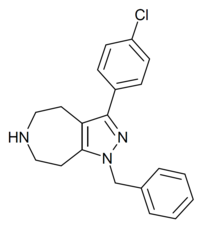JNJ-18038683
Jump to navigation
Jump to search
 | |
| Identifiers | |
|---|---|
| |
| CAS Number | |
| PubChem CID | |
| ChemSpider | |
| UNII | |
| Chemical and physical data | |
| Formula | C20H20ClN3 |
| Molar mass | 337.85 g·mol−1 |
| 3D model (JSmol) | |
| |
| |
JNJ-18038683 is a potent and selective antagonist of the 5HT7 serotonin receptor discovered by Johnson & Johnson. It has nootropic and antidepressant effects in both animal and human studies and has progressed to Phase II trials as an adjunctive treatment for improving cognition and mood in stable bipolar disorder; it has been found to reduce REM sleep (the lightest stage of sleep, elevated in depression) in humans and block circadian rhythm phase-shift advances in mice.[1][2]
It binds to the 5-HT6 serotonin receptor with 10x less affinity.[3] At relevant doses, inhibition of 5-HT6 would be expected to render pro-cognitive and anti-dementia effects.[4][5]
References
- ^ Bonaventure P, Dugovic C, Kramer M, De Boer P, Singh J, Wilson S, et al. (August 2012). "Translational evaluation of JNJ-18038683, a 5-hydroxytryptamine type 7 receptor antagonist, on rapid eye movement sleep and in major depressive disorder". The Journal of Pharmacology and Experimental Therapeutics. 342 (2): 429–440. doi:10.1124/jpet.112.193995. PMID 22570363. S2CID 10418102.
- ^ Shelton J, Yun S, Losee Olson S, Turek F, Bonaventure P, Dvorak C, et al. (2014). "Selective pharmacological blockade of the 5-HT7 receptor attenuates light and 8-OH-DPAT induced phase shifts of mouse circadian wheel running activity". Frontiers in Behavioral Neuroscience. 8: 453. doi:10.3389/fnbeh.2014.00453. PMC 4295543. PMID 25642174.
- ^ "JNJ-18038683 FREE BASE". www.chemsrc.com. Retrieved 2022-01-07.
- ^ Andrews M, Tousi B, Sabbagh MN (June 2018). "5HT6 Antagonists in the Treatment of Alzheimer's Dementia: Current Progress". Neurology and Therapy. 7 (1): 51–58. doi:10.1007/s40120-018-0095-y. PMC 5990506. PMID 29728891.
- ^ González-Vera JA, Medina RA, Martín-Fontecha M, Gonzalez A, de la Fuente T, Vázquez-Villa H, et al. (January 2017). "A new serotonin 5-HT6 receptor antagonist with procognitive activity - Importance of a halogen bond interaction to stabilize the binding". Scientific Reports. 7 (1): 41293. Bibcode:2017NatSR...741293G. doi:10.1038/srep41293. PMC 5259792. PMID 28117458.
Categories:
- Articles with short description
- Short description matches Wikidata
- Articles without EBI source
- Chemical pages without DrugBank identifier
- Articles without KEGG source
- Drugs missing an ATC code
- Drugs with no legal status
- Articles containing unverified chemical infoboxes
- Serotonin receptor antagonists
- Nitrogen heterocycles